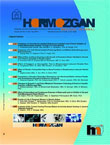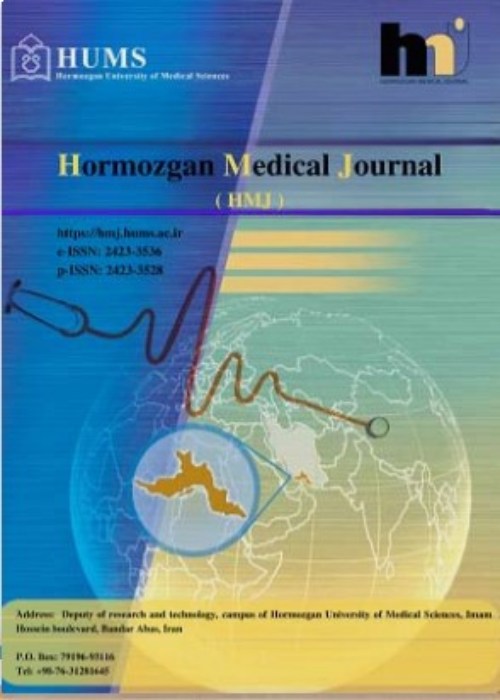فهرست مطالب

Hormozgan Medical Journal
Volume:21 Issue: 3, Aug-Sep 2017
- تاریخ انتشار: 1396/06/05
- تعداد عناوین: 8
-
-
صفحات 147-152
-
Pages 147-152IntroductionCutaneous leishmaniasis (CL) is a parasitic skin infection which can be debilitating. This study was performed to determine the vascular changes in the histopathology of CL.MethodsThirty-seven patients with CL were included in a prospective study. A 4 mm punch biopsy was obtained from the border of the lesion. After histopathologic processing and H&E staining, it was reviewed by a pathologist. In addition, 285 cases of CL, whose biopsy files were restored at the pathology ward, during a 23 year period, were reviewed for the assessment of vascular changes. Immunoperoxidase staining for IgG and IgA was also performed on paraffin-embedded blocks.ResultsOut of the 37 patients with CL, 64.7% were male and 35.3% were female. In this group, 73.5% had chronic and 26.5% had acute CL. The most common type of lesion was an ulcerated plaque. Of the total of 322 biopsy files that were reviewed, 34 (10.5%) had vascular changes in their lesions. The vascular changes included moderate to severe perivascular lymphocytic infiltration and severe perivascular lymphocytic infiltration with obstruction or narrowing of vessels with or without destruction. A few cases showed endothelial proliferation of blood vessels and one case had leukocytoclastic vasculitis.ConclusionCL should be considered in the differential diagnosis of chronic cutaneous ulcers in endemic areas, which demonstrate vascular changes or vasculitis in their pathology. Severity of the disease may be due to the underlying intense local inflammatory reaction, manifested as lymphocytic vasculitis.Keywords: Cutaneous, Leishmaniasis, Vascular Changes, Histopathology
-
Pages 153-158IntroductionHuman Toxocariasis is a zoonotic helminthic infection caused by migration of larval stage of Toxocara canis and Toxocara catti (T.canis and T.catti) that mainly affects children. The purpose of this study was to evaluate the frequency of anti-Toxocara antibody IgG in serums of 5-15-years-old children referred to Bandar Abbas and rural parts of nearby health centers. Along with Antibody detection, complete blood count (CBC) performed for hallmark of migratory parasites, eosinophil cells.MethodsThis study was designed to detect the anti-Toxocara antibodies in children in Bandar Abbas, Iran. In this study, ELISA (IBL kit), method on serum of 5-15 years old children who had already been examined by physicians to record signs and symptoms relevant to Toxocariasis was performed.ResultsThe frequency of anti-Toxocara antibody was 0.9%9 (6.650 cases) with no significant gender differences. Eosinophilia (blood eosinophil count higher than 600/mm3) was significantly related to the presence of a positive ELISA results.ConclusionBandar Abbas has a warm and humid tropical climate. Transmission of zoonotic parasite can be halted or diminished in these conditions. Low frequency of infected cases and rare positive serology results, along with other studies in other tropical regions confirm the effects of environmental conditions on parasite life cycle.Keywords: Toxocara Canis, Toxocariasis, Toxocara Infection, Visceral Larva Migrans
-
Pages 159-168IntroductionThe existence of pharmaceuticals in aquatic ecosystem, their persistence and possible effects on living organisms and inefficient systems in removal of these compounds from water and wastewater are a growing concern. In this research, the UV/TiO2 photocatalytic degradation of Cefixime was investigated so as to identify if this method was efficient for removal of Cefixime or not.MethodsThe experimental parameters like as primary concentration of Cefixime, catalyst dosage, solution pH and time were assessed and optimized. The photocatalytic analysis was based on residual Cefixime identification by HPLC. The chromatographic conditions were comprised of a reversed‐phase C18 column with mobile phase consisting of 45:55 v/v mixture of Acetonitrile: water.ResultsThe optimum removal efficiency for Cefixime was obtained after 60 min (90.98%) when 1 mg/L TiO2 was used at pH=3. The increase of catalyst concentration from 1 to 70 mg/L led to a decrease in degradation efficiency.ConclusionAccording to results, UV/TiO2 process could be a promising technique for the removal of Cefixime with good efficiency in a relatively short reaction timeKeywords: Cefixime, Removal, HPLC, Photocatalytic
-
Pages 169-177IntroductionL-Arginine supplementation improves antioxidant defenses through L-Arginine/nitric oxide pathways. This investigation assesses the influences of acuteL-Arginine supplementation on selected markers of delayed onset muscle soreness (DOMS) after one by one heavy eccentric exercise in healthy young females.MethodsTwelve healthy young females students of the University of Mohaghegh-Ardabili voluntarily participated in a double-blind randomized-controlled crossover trial to estimate the effects of 3g L-Arginine oral supplementation versus placebo (3g glucose) following an unaccustomed heavy eccentric exercise. L-Arginine (ARG) or placebo (PLC) was taken immediately after squat exercise, separated by 10day washout. Measurements were conducted at baseline, 24, and 48h after exercise comprising: (a) TAC (b) CK (c) LDH (d) Visual Analogue Scale (VAS) (e) Range of Motion (ROM) of both knees (f) Edema of both thighs. For data analysis software SPSS version 20 was used. To analysis the data, analysis of variance with repeated measure was used.ResultsTAC significantly increased 48h after exercise compared with the pre-exercise just in ARG group (P0.05).ConclusionThe findings of this study suggest that acute supplementation of ARG after heavy eccentric exercise may alleviate muscle damage through promoting the antioxidant capacity, protein synthesis, or decrease of lactate accumulation.Keywords: Creatine Kinase (CK), Lactate dehydrogenase (LDH), Visual Analogue Scale (VAS)
-
Pages 178-187IntroductionRenal ischemia reperfusion (I/R) caused kidney injury gender dependently. High fat diet (HFD) contributes the development of renal dysfunction. L-arginine (L-arg) and regular exercise are recognized to be protective in I/R and lipotoxicity. We compared the role of aerobic exercise and L-arg supplementation against renal I/R in male and female rats fed with HFD.Methods54 adult male and female Wistar rats received standard control diet (control), HFD, HFD plus L-arg (HFD±L-arg) or HFD plus aerobic exercise (HFD±EX) for 8 weeks. Then the animals were subjected to renal I/R by clamping renal vessels for period of 45 min followed by 24 hour reperfusion.ResultsThe serum levels of blood urea nitrogen (BUN) and creatinine (Cr), and kidney tissue damage score (KTDS) were not significantly different between HFD and control groups in two genders. However, the serum level of nitrite and kidney tissue level of malondialdehyde (MDA) in HFD fed male rats increased significantly (PConclusionThese results indicated that L-arg and aerobic exercise could ameliorate renal I/R induced kidney injury in HFD male rats but not in female.Keywords: Renal Ischemia Reperfusion, High Fat Diet, L-arginin, Aerobic Exercise
-
Pages 188-199IntroductionAlthough chronic ankle instability (CAI) is a condition characterized by numerous ankle sprains and the recurring sensation of ankle instability, which result in activity limitations and participation restrictions. Repetition based balance training protocols on type of the balance exercises may improve the deficits often associated with CAI. The objective of this study was to determine the effect of 6 weeks repetition based balance training on movement control, balance and performance in females with CAI.MethodsA total of 30 active female with CAI were selected for this study and randomly divided into control and experimental groups. Before and after the 6 weeks repetition based balance training intervention, participants were tested by completing the Mischiati test for movement control, Y balance test for balance and the Figure-8 hop and triple- crossover hop for performance. For statistical analysis, we conducted paired and sample t tests the data were analyzed using software SPSS 16 P≤0.05 was considered significant.ResultsThe repetition-based balance protocol group improved the movement control (P=0.004), balance (P=0.006), figure-8 hop (P=0.001) and triple- crossover hop (P=0.003) performance.ConclusionDespite some limitations, the findings clearly support the use of repetition- based balance training exercises to improve movement control, balance and performance in females with CAI. Thus, future researchers should consider not only larger sample sizes but also longer-duration training programs to ensure the presence of notable adaptations in sensorimotor control that can.Keywords: Chronic, Performance, Movement
-
Pages 200-207IntroductionThis study aimed to evaluate the effectiveness of teaching communication skills and sexual difference (sexual knowledge) on marital satisfaction in couples referred to the Mashhad city Health Center, Iran.MethodsIn This Quazi-experimental study, with pre test and post-test methods, 25 coups who referred to a Mashhad city health center, were randomly selected. Enrich marital satisfaction questionnaire was used to measure variables. Teaching communication skills and sexual difference as independent variables were held during 2 months in 14 sessions (communication skills in seven 2-hours sessions and sexual differences (sexual knowledge) in six 60-minutie sessions). Paired T-test has used for data analysis.ResultsResults showed that there is significant difference between pre-test and post-test scores (PConclusionResults of this study indicated that teaching communication skills and sexual differences (sexual knowledge) were effective on martial satisfaction and enhancement of psychological well-being of couples.Keywords: Marital, Skills, Sexual Difference
-
Pages 208-217IntroductionTo get updated, nurses need to attend in-service training courses. E-learning is a promising solution for providing courses to busy nurses in teaching hospitals. This study aims to evaluate the readiness of teaching hospitals for e-learning implementation specialized for nurse's in-service trainings.MethodsThis descriptive-analytical survey was carried out in Bandar Abbas (Iran) teaching hospitals affiliated to Hormozgan University of Medical Sciences (HUMS) from March to June 2016. It included nursing staff, trainers, and related hospital and HUMS authorities. Questionnaires and checklists adopted from earlier studies and customized for this study were used for data collection. Appropriate descriptive and inferential statistical formulas were applied using SPSS version 19.ResultsData showed that HUMS; in general, was in an optimum situation for e-learning implementation regarding manpower, financial support, technical equipment, strategic plan, content authoring and access to the internet. However, access to information resources and digital library was not good. Hospital authorities stated that they had lack of manpower and required infrastructure. Some of them doubted the appropriateness of e-learning for clinical trainings. Apart from knowledge dimension, nurses reported significantly higher than the average on other study dimensions.ConclusionTo implement e-learning for nurse's in-service trainings, HUMS must hire experts for authoring and producing content; and technical staff for maintenance the infrastructure. Moreover, e-learning knowledge and skills of people involved in e-learning needs to be improved.Keywords: E-Readiness, Nurses, In-Service Training


